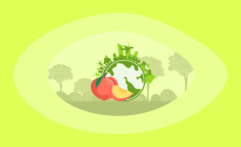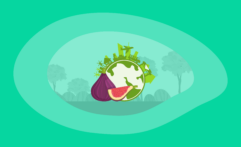The Environmental Impact of Watermelons: From Farm to Table
Impactful Ninja is reader-supported. When you buy through links on our site, we may earn an affiliate commission.
Learn more
Learn more
.
Hey fellow impactful ninja ? You may have noticed that Impactful Ninja is all about providing helpful information to make a positive impact on the world and society. And that we love to link back to where we found all the information for each of our posts. Most of these links are informational-based for you to check out their primary sources with one click. But some of these links are so-called "affiliate links" to products that we recommend. First and foremost, because we believe that they add value to you. For example, when we wrote a post about the environmental impact of long showers, we came across an EPA recommendation to use WaterSense showerheads. So we linked to where you can find them. Or, for many of our posts, we also link to our favorite books on that topic so that you can get a much more holistic overview than one single blog post could provide. And when there is an affiliate program for these products, we sign up for it. For example, as Amazon Associates, we earn from qualifying purchases. First, and most importantly, we still only recommend products that we believe add value for you. When you buy something through one of our affiliate links, we may earn a small commission - but at no additional costs to you. And when you buy something through a link that is not an affiliate link, we won’t receive any commission but we’ll still be happy to have helped you. When we find products that we believe add value to you and the seller has an affiliate program, we sign up for it. When you buy something through one of our affiliate links, we may earn a small commission (at no extra costs to you). And at this point in time, all money is reinvested in sharing the most helpful content with you. This includes all operating costs for running this site and the content creation itself. You may have noticed by the way Impactful Ninja is operated that money is not the driving factor behind it. It is a passion project of mine and I love to share helpful information with you to make a positive impact on the world and society. However, it's a project in that I invest a lot of time and also quite some money. Eventually, my dream is to one day turn this passion project into my full-time job and provide even more helpful information. But that's still a long time to go. Stay impactful,Affiliate Disclosure
Why do we add these product links?
What do these affiliate links mean for you?
What do these affiliate links mean for us?
What does this mean for me personally?
![]()
A summer picnic isn’t complete without some watermelon slices. They are a hydrating fruit, containing over 90% water, as well as protein and fiber. Watermelons are a quintessential American crop, as one of the top three agricultural products produced in the country. But the production of watermelons can also have a severe impact on the environment. So we had to ask: What is the environmental impact of watermelons?
Watermelons have a very negative environmental impact. This is largely due to their low land yields, high pesticide and irrigation use, and low composting rates. Their environmental impact is high compared to other fruits.
In this article, we will examine the environmental impact of watermelons from several different angles. We will go through the life-cycle of watermelons, detailing their impact on the environment from growth to distribution to your plate to waste management. We will then compare the environmental impact of watermelons to that of other fruits. And, finally, we’ll share some tips with you on how you can reduce your own environmental impact and offset your own carbon emissions – both for your personal life and watermelon-related.
Here’s How We Assessed the Environmental Impact of Watermelons
The Environmental Impact Assessment (EIA) is one of the ways we measure the potential environmental effects of our actions, like the consumption of watermelons. It is a holistic assessment based on the environmental changes associated with our consumption. Those are changes in our environment that can have adverse effects on the air, land, water, fish, and wildlife or the inhabitants of the ecosystem.
“Environmental Impact: the effect that the activities of people and businesses have on the environment”
Cambridge Dictionary
Basically, all goods and services you buy – including watermelons – leave an impact on our environment. When it comes to food in general, and watermelons in specific, the following are key factors:
- Land requirements: Large parts of the world that were once covered by forests and wildlands are now used for agriculture. 10 million hectares of forest are destroyed annually and 50% of the world’s habitable land is now used for agriculture. This loss of natural habitat has been the main driver for reducing the world’s biodiversity.
- Water footprint: 70% of global freshwater is now used for agricultural purposes. By assessing the water footprint of a particular food, we can determine how our limited freshwater resources are being consumed and polluted.
- Pesticide and fertilizer usage: Pesticides and fertilizers provide a range of agricultural benefits. However, numerous studies link pesticides and fertilizers to serious effects on human health, along with disruptions to vital ecosystems and the spread of aquatic dead zones.
- Carbon footprint: The carbon footprint is one of the ways we measure the effects of our human-induced global climate change. Today, food production accounts for over a quarter (26%) of global greenhouse gas emissions.
- Waste generation: Food and its packaging account for almost 45% of the materials landfilled in the US alone. And packaging sent to landfills, especially when made from plastics, does not degrade quickly or, in some cases, at all.
To understand the overall environmental impact of watermelons, we must assess each of their key factors. This Environmental Impact Assessment (EIA) is a tool originally developed to identify the environmental impacts of a project prior to decision-making and also helps us to evaluate the environmental impacts of watermelons, from farm to table.
Here’s the Overall Environmental Impact of Watermelons
The overall environmental impact of watermelons is negative. Though they have a low carbon footprint, their heavy use of pesticides, high irrigation requirements, and low land yield mean that they impact the environment very negatively.
Watermelons have some less negative environmental impacts. For one thing, they don’t use the worst types of packaging, opting for cardboard instead of plastic or styrofoam, and they have a very low carbon footprint. However, these things aren’t the whole story, and watermelons still have plenty of negative qualities when it comes to their environmental impact.
So, let’s have a look at the environmental impact of each key factor of watermelons!
| Key Assessment Factors | Environmental Impact |
| Land requirements for watermelons | Watermelons’ land requirements are very high. This, mixed with their tendency to be farmed in monocultures means their environmental impact is very negative at this stage. |
| Water footprint of watermelons | Watermelons have a high water footprint of 50–100 inches of water per year.Their high irrigation needs contribute negatively to their environmental impact. |
| Agrochemical usage for watermelons | The pesticide and fertilizer usage for watermelons is very high. The particular fertilizers they use are also harmful to soil and local wildlife. |
| Carbon footprint of watermelons | Watermelons have a low carbon footprint of 0.05kg (0.11 lb) of CO2e per pound of watermelon. They are produced domestically in the US and have a minimal harvesting, processing, and packaging footprint; despite their high pesticide usage and low composting rates. |
| Waste generation of watermelons | Watermelons’ waste generation is moderate. They use cardboard, which is easy to recycle, but have low composting rates for their food waste. |
These are the overall summaries, but there is a lot more to the story. In the next few sections, we will dive deeper into each stage to illustrate all the important aspects of watermelons’ environmental impact.
What Are the Land Requirements for Watermelons
Watermelons’ land requirements are very high. This, mixed with their tendency to be farmed in monocultures means their environmental impact is very negative at this stage.
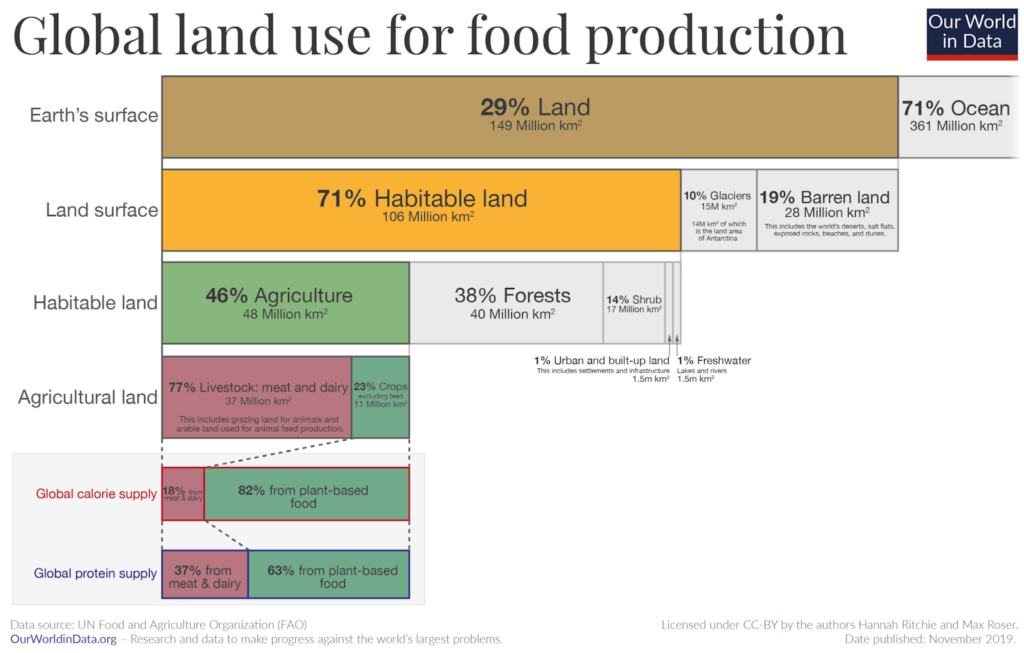
Growing watermelons has a lot of variables that contribute to their environmental impact. The amount of land they use, the way in which they grow, and the amount of time they take to grow will all contribute to their environmental impact.
How do the land requirements of watermelons impact their environmental footprint?
- What is the land usage of watermelons: Watermelons have very high land usage, yielding only around 2–3 tons per hectare. This is an extremely low-density planting cycle compared to other fruits. For example, strawberries yield around 15–25 tons per hectare and bananas up to 100 tons per hectare. This low yield means that watermelons take up more space per pound than other fruits and thus require more land to farm.
- Where and how are watermelons grown: Most watermelons in the world grow in China, with Turkey in second place. Watermelons grow on vines along the ground. Watermelons and other squash family foods don’t naturally sequester carbon like trees. However, efforts are being made to change this by introducing regenerative farming techniques. Many watermelons are grown in monocultures, which means that there are no other plants around. Monocultures lack biodiversity and thus are bad for wildlife and soil microbes. These factors combine to create a negative environmental impact for watermelons at this stage.
- How does the watermelon industry affect the loss of habitable land: Watermelons grow in very low-density environments, which means that they need a lot of land to sustain them. Watermelons, in particular, contribute to an environmental phenomenon known as “desertification”. Desertification is the process by which agriculture depletes the soil of a region, turning it into a desert in just a few years. Watermelons, particularly in China, are notorious for desertifying large swaths of land.
- How does the watermelon industry affect wildlife and biodiversity: The process of desertification is not only harmful for future agriculture, but for local wildlife as well. It can be just as harmful as deforestation in terms of habitat loss. It also depletes food sources for local wildlife.
In short, watermelons’ extremely low land yield and monoculture farming means that this stage in their life cycle has a considerably negative environmental impact.
What Is the Water Footprint of Watermelons
Watermelons have a high water footprint of 50–100 inches of water per year. So, they have high irrigation needs which contribute negatively to their environmental impact.
Water usage is one of the most important factors in the environmental impact of a fruit. The amount of water used, as well as the way they affect the water sources around them, are all major contributing factors. Here, we will look at these different angles to watermelons’ water impact.
How does the water footprint of watermelons impact their environmental footprint?
- What is the overall water usage of watermelons: Watermelons need around 50–100 inches of water per year. This is a very high water requirement compared to other fruits. For example, mangoes only need 26–52 inches per year.
- What is the green water footprint of watermelons: The green water footprint is the amount of water from precipitation stored in the soil and used by plants for growth. Watermelons are primarily grown in the southern US, mostly in Arizona and California. Arizona gets around 12 inches of rainfall per year and California gets around 23 inches per year. Therefore, all the rainfall in the area will be going to watermelon farms.
- What is the blue water footprint of watermelons: The blue water footprint is the amount of water sourced from surface (such as rivers or lakes) or groundwater resources. Since the annual rainfalls of both Arizona and California are too low to meet watermelons’ water requirements, they will require significant irrigation. Irrigation has a negative environmental impact, due mainly to its high carbon footprint and modification of groundwater balance.
- What is the gray water footprint of watermelons: The gray water footprint is the amount of freshwater required to clean up water pollution to meet certain quality standards. Essentially, it’s the amount of water needed to make polluted water clean enough to be safe and healthy for humans and the environment. Unfortunately, watermelons have been found to have very high pesticide use. Pesticides pollute the groundwater, meaning excess water is required to clean them up. Their high pesticide use means that a significant amount of water will be needed to compensate for watermelons’ groundwater damage.
- How does the watermelon industry affect freshwater and ocean pollution: Watermelons use very high amounts of pesticides, as well as nitrogen fertilizer. Both nitrogen fertilizer and pesticides are very harmful to groundwater. Nitrogen fertilizer in particular causes invasive growth of algae which can wreak havoc on water systems and endanger marine life.
In short, watermelons’ high irrigation requirements and high pesticide use means that they have a significant water footprint.
What Is the Agrochemical Usage for Watermelons
The pesticide and fertilizer usage for watermelon is very high. The particular fertilizers they use are also harmful to soil and local wildlife.
Pesticides and fertilizers can have a significant impact on the environment. They both require resources to create as well as have effects on the life around them. Here, we will look at how watermelons’ pesticide and fertilizer rates affect their environmental impact.
How does the pesticide and fertilizer usage of watermelons impact their environmental footprint?
- What is the pesticide usage of watermelons: Watermelons have high pesticide usage. Pesticides have a negative impact on the environment because they pollute groundwater, have a high carbon footprint, and can even harm wildlife.
- What is the fertilizer usage of watermelons: Watermelons use mainly nitrogen fertilizer at the beginning of life, then phosphorus and potassium later on. Potassium has minimal environmental impacts. However, nitrogen has been known to be very harmful to the environment.
- Are there any known issues connected to the agrochemical usage for watermelons: Watermelons’ use of nitrogen fertilizer has many issues associated with it. For one, it can cause air pollution which affects humans, animals and plants alike. Nitrogen fertilizer causes oxygen depletion and contributes to dead zones in water sources, particularly around the Gulf of Mexico and other vital habitats.
In short, watermelons’ high pesticide use as well as their use of harmful nitrogen fertilizer means their environmental impact is very negative at this stage.
What Is the Carbon Footprint of Watermelons
Watermelons have a low carbon footprint of 0.05kg (0.11 lb) of CO2e per pound of watermelon. They are produced domestically in the US and have a minimal harvesting, processing, and packaging footprint; despite their high pesticide usage and low composting rates.
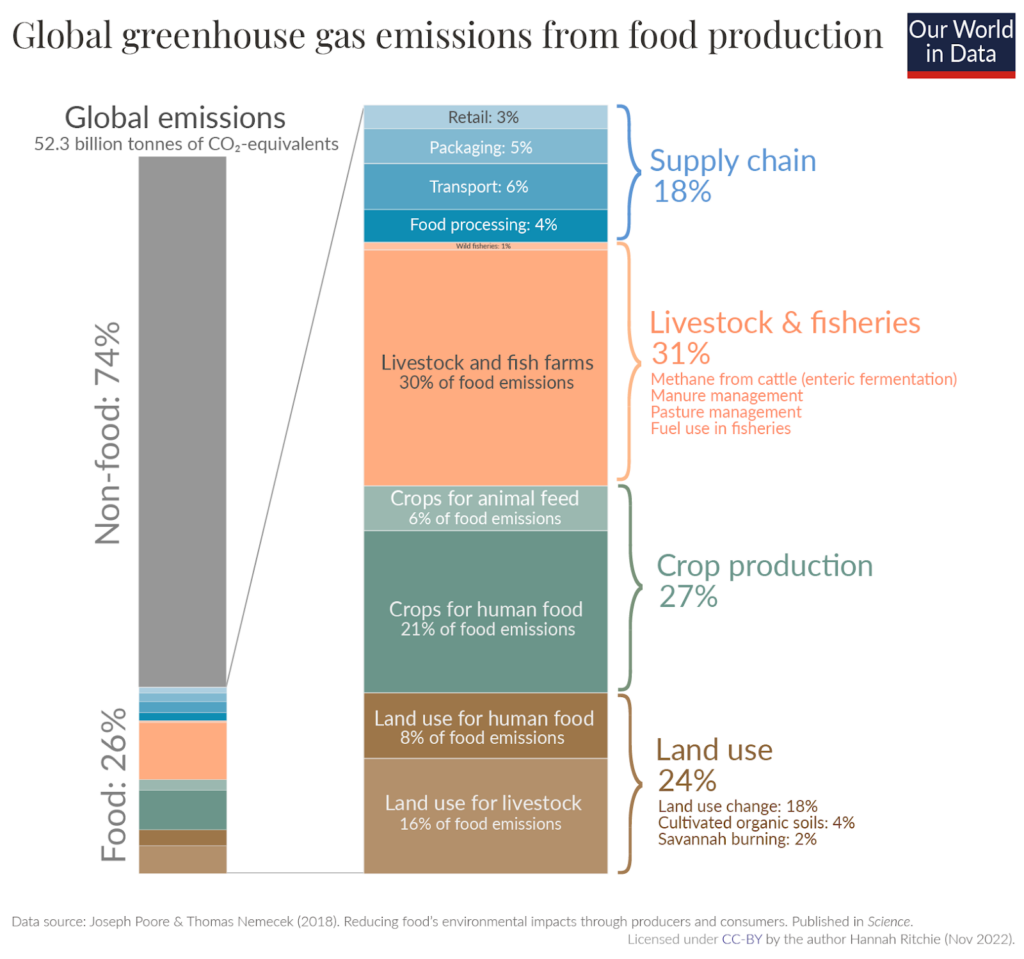
Carbon footprint is one aspect of the overall environmental impact of a fruit. It essentially measures how much carbon or other greenhouse gasses the production of watermelons emits into the atmosphere. Emissions from product manufacturing, irrigation, transportation fuel, and landfills all add up to create the overall carbon footprint of a fruit. Let’s see how the carbon footprint of watermelons breaks down and contributes to their environmental impact.
How does the carbon footprint of watermelons impact their environmental footprint?
- What is the overall carbon footprint of watermelons: The overall carbon footprint of watermelons is very low at 0.05kg (0.11 lb) of CO2e per pound of watermelon. This means that for every pound of watermelons produced, 0.05kg of carbon is released into the atmosphere. This is one of the lowest carbon footprints among fruits.
- What are the main contributors to the carbon footprint of watermelons: The main factors that affect their carbon footprint are high pesticide use, low composting rates, low-density agriculture, and refrigeration during transportation.
- Which life-cycle stage of watermelons has the highest carbon footprint: The stage that contributes the most to watermelons’ carbon footprint is growth. This is because of their low-density planting and high pesticide use.
In short, watermelons have certain high-carbon components to their life cycle, such as low-density farming, but overall they have one of the lowest carbon footprints amongst fruits.
What Is the Waste Generation of Watermelons
Watermelons’ waste generation is moderate. They use cardboard, which is easy to recycle, but have low composting rates for their food waste.
When fruit waste, either packaging or organic materials, is disposed of, they can have a major impact on the environment. Whether it’s damaging wildlife, getting into oceans, emitting methane, or dissolving into microplastics that contaminate groundwater, all these materials have their part to play. In this section, we will look at how watermelon waste affects the environment.
How does the waste generation of watermelons impact their environmental footprint?
- What is the packaging of watermelons: Watermelons typically use cardboard during the transportation stage. Cardboard has a negative environmental impact, mainly through their contribution to deforestation.
- How is the packaging of watermelons disposed of: Cardboard recycling has a fairly high recycling rate of around 89%. However, this still means that some cardboard is ending up in landfills. Landfills have a negative environmental impact because they emit carbon, pollute the soil, and harm wildlife. So if even a small amount of cardboard is going into landfills, it is still harming the environment.
- How are watermelons disposed of: Watermelons have rinds that can theoretically be composted. However, composting rates amongst food waste are very low, at around 4%. This means that the vast majority of watermelon waste is ending up in the landfills. On top of the general negative qualities of landfills, food waste is particularly bad, since it releases methane.
In short, watermelons’ low composting rate and use of cardboard packaging contribute to a moderately negative environmental impact at this stage.
What Have Been Historical Environmental Issues Connected to the Watermelon Industry
Watermelons have partaken in some farming practices that have harmed the environment a lot over the years. These include deforestation, desertification, and use of contaminating fertilizers and pesticides.
All fruits have had a complex road toward global distribution. They originate in one part of the world and often travel far to end up in your local supermarket. From farm to table, some of our favorite fruits have racked up some serious environmental damage along the way. Whether it’s deforestation to meet demand, water pollution, or disruption of wildlife, most fruits have left a path of destruction. Let’s see how watermelons have fared throughout history.
What have been the key historical environmental issues of the watermelon industry?
- How much land has been lost because of watermelon production: Watermelon production has used around 3 million hectares of land to date. This land usage represents not just deforestation, but also potential desertification as these watermelon farms deplete surrounding resources.
- Which wildlife species have been negatively impacted or displaced because of watermelon production: Much of the deforestation and desertification caused by watermelons has harmed wildlife. Many animals use these regions and resources as their habitats, which are lost when agriculture replaces them. Habitat loss is the #1 cause of endangered species.
- Have water sources and soil been contaminated because of watermelon production: Watermelon production has caused severe droughts. In particular, Northern Morocco, which is a major watermelon-producing region, has seen significant droughts due to how much water watermelons consume. Their use of pesticides and nitrogen fertilizer has also harmed the environment over the years. The accumulation of nitrogen in soils has now become a significant component of its environmental impact.
In short, watermelons have caused some significant damage to the environment. Their use of nitrogen fertilizer, and pesticides, as well as their high land requirements have all contributed to this.
What Is the Overall Environmental Impact of Food and Agriculture
Food production in general has a high environmental impact. Everything from the amount of land used to the energy involved in irrigation to its effect on plant and animal biodiversity can be a factor in this. In the chart below, you can see how food production is one of the biggest influences on these areas of the environment.
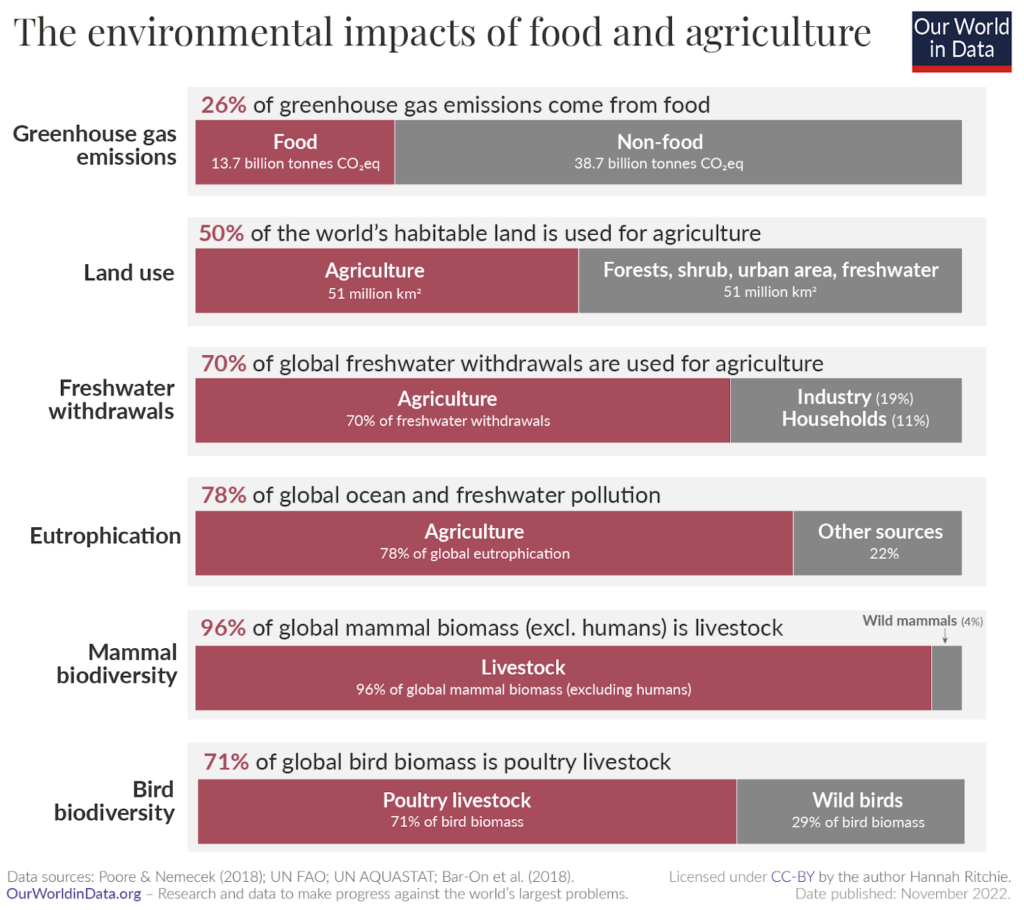
Agriculture alone accounts for over a quarter of global greenhouse gas emissions, while using half of the world’s habitable land and 70% of the global freshwater withdrawals. Agriculture also causes 78% of the global ocean and freshwater pollution.
Livestock accounts for the vast majority of non-human mammal and bird biomass. Mammal livestock outweighs wild mammals by a factor of 15-to-1, and poultry livestock outweighs wild birds by a factor of more than 3-to-1.
These statistics highlight the need for sustainable and responsible practices in food production to reduce its impact on the environment. And the need for us to shift toward more environmentally-friendly foods.
How Can You Reduce Your Environmental Impact and Offset Your Personal Carbon Footprint
There are a few things you can do to mitigate some of the negative environmental effects of consuming watermelons, while still enjoying them. You can also consider offsetting your personal and watermelon-related carbon emissions, which work to remove carbon emissions elsewhere that are then attributed to you. Here, we will walk you through how to accomplish both of these things.
How Can You Reduce Your Environmental Impact When Shopping for Watermelons
In this section, we give you a short list of ways you can reduce the negative environmental effects of watermelons, based on those parts of the life-cycle of watermelons that would otherwise most negatively impact the environment:
- Buy Florida watermelons: One of the biggest contributors to watermelons’ environmental impact is their high irrigation requirements. Florida gets considerably more rainfall than Arizona and California, around 54 inches a year. This means that watermelons grown in Florida need considerably less irrigation than those grown in Arizona or California. Buying watermelons from Florida will help you reduce your water footprint.
- Compost and recycle: Waste disposal and landfills are big negative contributors to watermelons’ environmental impact. If you make sure that you recycle any packaging and compost any food waste, then you will be greatly reducing your impact in this area.
- Buy organic watermelons: Watermelons’ high pesticide use is a major contributor to their environmental impact. Organic farms commit to not using chemicals like pesticides. If you support organic watermelon farming then you will be able to reduce your environmental impact in this area.
Following some of these methods can really help you to cut down on your environmental impact of eating watermelons. None of these will completely eradicate these negative impacts, since there are always effects that may be outside of your control. But some reduction is always better than nothing!
How Can You Offset Your Personal Carbon Footprint
The carbon footprint is a key part of your environmental impact. And it is one of the ways we measure the effects of our human-induced global climate change. Yes, even from eating watermelons!
“Carbon footprint: the amount of greenhouse gasses and specifically carbon dioxide emitted by something (such as a person’s activities or a product’s manufacture and transport) during a given period”
Merriam Webster
Basically, it is the amount of carbon emitted by you as an individual or an organization providing you with goods and services – including watermelons:
- This includes GHG emissions from producing the products that we use and foods that we eat (e.g., power plants, factories or farms, and landfills)
- GHG emissions from fuel that we burn directly or indirectly (e.g., logistics and transportation, cooling or heating facilities),
- as well as the GHG emissions attributed to how we consume these products and foods.
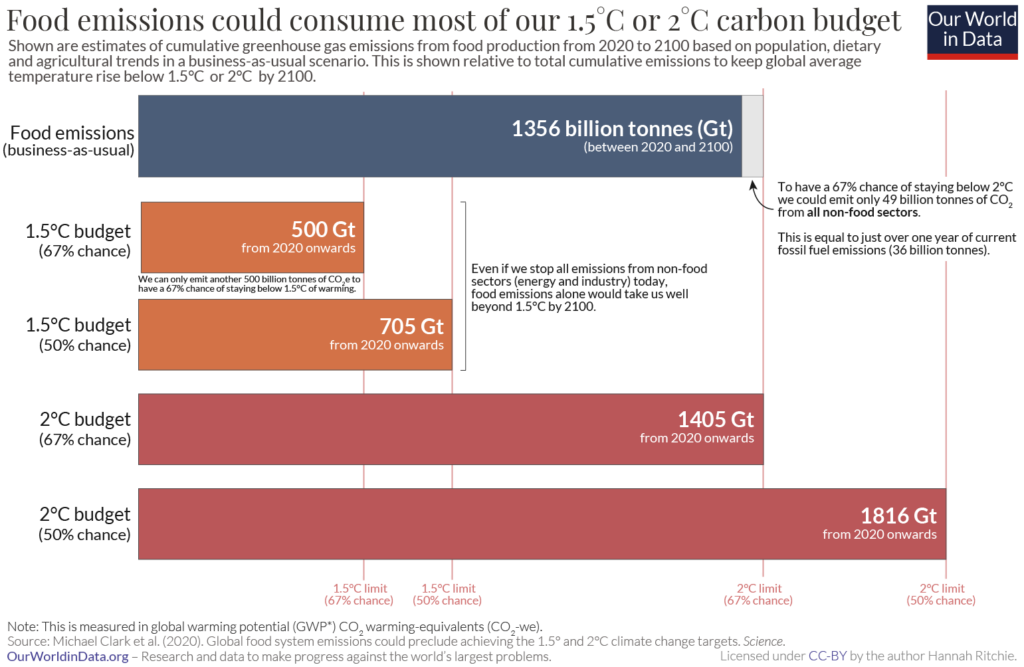
Carbon offsets are reductions in carbon emissions that are used to compensate for carbon emissions occurring elsewhere – for example for the carbon emissions that are associated with watermelons. They are measured in tons of CO2 equivalents and are bought and sold through international brokers, online retailers, and trading platforms on what is known as the global carbon offset market.
“Carbon Offset: a way for a company or person to reduce the level of carbon dioxide for which they are responsible by paying money to a company that works to reduce the total amount produced in the world, for example by planting trees”
Oxford Dictionary
In terms of watermelons – and indeed all food types – there will always be a carbon footprint, because of the resources it takes to get your food from farms to the place where you’ll eventually eat them. And while there are ways to reduce your carbon footprint when shopping for watermelons, carbon offsets would be a way to reduce your CO2e emissions all the way down to net zero (or even to become climate positive).
However, when you purchase carbon offsets, it’s important that they actually make a difference in offsetting (aka reducing) total carbon emissions. To achieve that, the following are key criteria:
- Carbon offset projects have to be effective (different projects have different effectiveness rates)
- Carbon offset projects have to be additional
- Carbon offset projects have to be permanent
- The claims from carbon offset projects have to be verifiable
To find the best carbon offsets for you personally, check out our full guide on the best carbon offsets for individuals, where you’ll also learn more about how these carbon offset projects work, what their respective offsetting costs are, and what your best way would be to offset your own carbon emissions.
Final Thoughts
Watermelons may be low in carbon footprint, but that’s not all there is to environmental impact. Given the other factors at play, such as use of monoculture planting, nitrogen fertilizers, and higher-than-average pesticides, watermelons create a lot of environmental damage. But there are plenty of things you can still do to reduce this impact. Buying organic or local and making sure to dispose of waste properly are some of the best ways to make sure that you are consuming watermelons responsibly!
Stay impactful,

Sources
- What About Watermelon: 32 Fun Facts About Watermelon
- Healthline: Watermelon 101
- AGMRC: Watermelon
- UN Environment Programme: Environmental Impact Assessment and Strategic Environmental Assessment: Towards an Integrated Approach
- Our World in Data: The environmental impacts of food and agriculture
- Our World in Data: Global land use for food production
- World Health Organization: Preventing disease through healthy environments: a global assessment of the burden of disease from environmental risks
- ScienceDirect (Biological Conservation): Worldwide decline of the entomofauna: A review of its drivers
- EPA: The Sources and Solutions: Agriculture
- EPA: Reducing Food Waste and Packaging
- FoodPrint: The Environmental Impact of Food Packaging
- BHG: How to Grow Watermelon
- Islamic Azad University: Energy-Use Pattern and Carbon Footprint of Rain-Fed Watermelon
- North Carolina State University: Yield Response of Watermelon to Planting Density
- Statistica: Strawberry Yield Scotland
- Impactful Ninja: What is the Carbon Footprint of Bananas
- World Atlas: Top Watermelon-Producing Countries in the World
- Gardeners Path: How to Plant and Grow Watermelons
- NPS: Carbon Storage by Urban Forests
- Labroots: Lowering the Carbon Footprint of Pumpkin Farming
- NCBI: Wheat Straw Increases the Defense Response of Watermelons
- EOS: Monoculture Farming Explained
- World Bank: China Fighting Desertification
- Iberdrola: What is Desertification?
- Impactful Ninja: What is the Carbon Footprint of Mangoes
- Peppers Home and Garden: How Much Water Do Mango Trees Need
- Water Footprint: What is a Water Footprint
- AZ Climate: Arizona
- OEHHA: California Climate
- Science Direct: Energy and Carbon Footprint of Irrigation
- World Atlas: Environmental Impact of Irrigation
- Graphic: Unacceptable Levels of Pesticides in Our Watermelon
- USGS: Pesticides in Groundwater
- EPA: Excess Nitrogen in the Atmosphere of Forests, Soils, and Waterways
- Pesticide.org: Pesticides and the Climate Crisis
- GOV.BC: Environmental Protection and Pesticides
- Yara: Best Fertilizers for Melons
- Plant Nutrition: Potassium
- Mitsui: Reducing the Environmental Impact of Chemical Fertilizer
- Impactful Ninja: What is the Carbon Footprint of Watermelons
- EPA: Reducing the Impact of Wasted Food
- USA Truckload Shipping: How Are Watermelons Transported
- ITF Net: Watermelon Post-Harvest Processing
- TRVST: Environmental Impact of Cardboard
- Also Known As: 12 Interesting Facts About Packaging Waste
- SL Recycling: What Are the Negative Effects of Landfill
- GOV.BC: Waste Management
- FAO: Watermelon
- WWF: Impact of Habitat Loss on Species
- Qantara: Water Shortage in the Maghreb
- Our World in Data: Global greenhouse gas emissions from food production
- Our World in Data: The environmental impacts of food and agriculture
- Weather Stem: Florida
- Our World in Data: Emissions from food alone would take us past 1.5°C or 2°C this century
- Impactful Ninja: Why Is a Carbon Footprint Bad for the Environment
- Impactful Ninja: Best Carbon Offsets for Individuals
